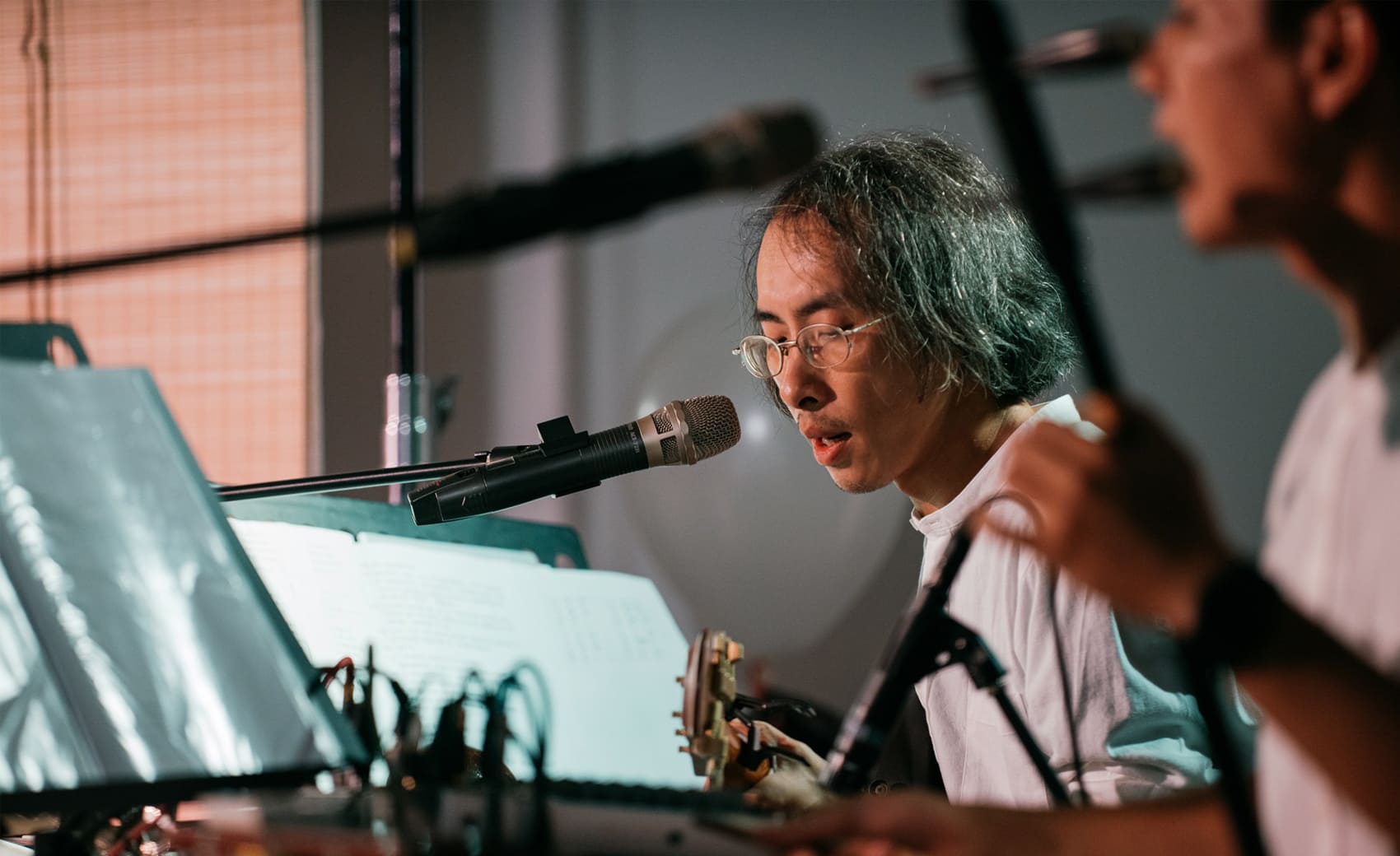劇團與促進轉型正義委員會合作,藉由說書、唸歌、民謠等民間以聲述史的敘事方式,重構白色恐怖時期未能被傳唱訴說的歷史記憶。編制過程參考大量史料檔案,由樂手與表演者對話演唱,以一虛構的底層農工所經歷的「出身、選擇、關押、審訊、自新、撿骨、遺書」做為軸線,夾敘夾議含納來自不同時空的受難者證言與事件表述,各地觀者得以設身處地的感受,受難者作為一個真實的「人」的樣貌及生命處境。劇團走唱七個發生白色恐怖事件的重要鄉鎮,亦在演出中融合這些地方的真實案例,除在歌謠與「聲音劇場」、傳統與當代的融合中,創造出一個屬於民間的多元辯證的敘事角度,亦將故事帶回其發生之地。整體計畫在音樂說書劇場演出外,尚包含親子工作坊和演後座談,邀請民眾與受難者家屬參與,分享家族故事,在劇場所搭建的平台中,讓歷史記憶與正義的議題得以在共同討論中被重新創造。
The theater troupe works with the Transitional Justice Commission and reconstructs the untold historical memories from the White Terror period through various narrative approaches, such as monologue storytelling, traditional folk singing and folk songs that recount history through verbal narration. A large number of historical archives was referenced in the writing of the script and the performance. The dialogues between and singing of musicians and performers were based on the experiences of a fictional underprivileged worker, and followed the storyline of his life – “family of origin, choices in life, arrest, trial, self-correction statements, searching of a victim’s remains and the undelivered letter” – to portray and discuss the victims’ testimonies and accounts of incidents from different times, enabling the audience from around the island to empathize with the victims as real “human beings” and the situations of their lives. The theater troupe performed in seven key towns in the history of White Terror, and incorporated real cases that had taken place in these locales. In addition to combining folk songs and “sound theater,” respectively representing the traditional and the contemporary, the work created a diversely dialectical narrative perspective belonging to the people while bringing stories back to where they first began. Apart from the theatrical performance enriched with singing and storytelling, the entire project also included parent-child workshops and after-performance talks, which invited the public and the victims’ family members to share their stories. Through this theatrical platform, historical memory and justice have been reinvented in collective discussion.
再拒劇團
2002年由臺灣80後世代不同領域藝術家組成。團名源自亞洲許多神話中的「童神」記述,以包含「死與再生」和「變身思想」的主題概念敘述其出生、歷劫與回歸神聖的歷程,意指劇場表現原點本該破立創新,在不同媒介結合的感官體驗中,創造新的美學經驗。劇團持續實踐「聲音劇場」及非制式劇場空間的跨域作品,為當代劇場藝術激盪出更具實驗性的展演想像。主要作品包括《公寓聯展》、《接下來,是一些些消亡》、《諸神黃昏》和《渾沌詞典:補遺》等。
Against Again Troupe
Founded in 2002 by artists born after the 80s and specializing in different fields, the name of the theater troupe originates from stories about the child-god, Nezha, in Asian mythologies that adopt the ideas of “death and rebirth” and “the concept of transformation” to depict his journey from birth, life challenges and returning to divinity. The name of the theatre troupe therefore indicates that theatrical endeavors should aim for shattering old practices to break new grounds while bringing together sensory perceptions enabled by different media to create fresh aesthetic experiences. The troupe has steadfastly realized “sound theater” and interdisciplinary work foregrounding non-standard theatrical space in hope of fostering more experimental theatrical imagination for contemporary theater arts. Their works include Against Again Apartment Showcase, All That's Left to Happen Is Some Deaths (My Own Included), Götterdämmerung, Dictionary of Chaos: Addendum and more.
促進轉型正義委員會
再拒劇團
黃思農
林欣怡
黃亭瑋、黃思農、蔣韜、曾伯豪
蔣韜、曾伯豪
劉淑娟、洪健藏
曾彥婷
劉柏欣
張以沁
張以沁、劉柏欣、黃昶智、羅婉瑜
吳韋瑩、張君如、鄒雅荃、羅婉瑜
林欣怡、曾伯豪
曾彥寧
黃亭瑋
田珈伃
詹雨樹
蔡采媛
邱唯婷
李彥
唐健哲
吳品萱、張景泓、唐健哲
王柏欣
高雄橋頭糖廠百世新天地
關鍵字
- 聲音劇場
- 史詩劇場
- 說書
- 七字古調
- 藍調歌謠
- 白色恐怖
- 鄉鎮巡迴
- 自新
- 布萊希特
- 疏離效果
- 無法送達的遺書
- 六張犁亂葬崗
藝術家談作品
《明白歌》有別於其他同題材創作,在於它免除二元對立窠臼,也不去強調何謂正義或正確一方,使得這段歷史書寫,在廣納眾聲喧嘩之下,真正對所有受難者表達出應有的平和尊重。
採訪及文字整理/吳家瑀
近年隨著白色恐怖史料解禁釋出,深藏於歷史暗角的一張張模糊面目,也在透光中逐漸顯影。面對過往的生離死別或政治隱傷,有人泫然有人憤惋,可任何的批判成見都只是另種形式的暴力,依舊使聲音繼續壓抑瘖啞、無可傾聽。再拒劇團2019年作品《明白歌|走唱白色記憶:未竟的故人事與未來歌》文本直接援引大量文獻,敘事方式結合民間說書歌謠,試圖以多重角色的聲音召喚歷史血肉,開創更生動多面的記憶回溯。
時代下的集體,故事裡的眾人
「劇場是關於當下的藝術,而如果你說,劇場從過去至今,作為一個儀式,本來就是連結生者與死者,連結過去事與未來事。那麼今天我們歌唱表演的整個目的,其實也就是回到這個劇場最原始的本質。」身兼導演及編劇的黃思農思索著,當官方立碑表揚仍無法撫慰傷靈、為真相補遺,民間該怎麼去訴說這些未竟事?所謂未竟事,對他而言,就是去把這些塵封卷帙的故事,還原成一個真實的人。
閱讀白色恐怖受難者書信輯錄《無法送達的遺書》使黃思農感觸甚深:「裡面許多過世的人都比我們現在此刻年輕,面對生命結束的時刻,他們寫下來的很多也不是政治理想,而是給生者的祝願。這裡給我很大的衝擊,是來自於他們就是活生生的人。」音樂設計暨樂手,同時也參與編劇的蔣韜說,「本劇是希望為小人物作史,形成一個以個別訴說眾人的故事,如此也將戲的格局架構打開」。
然而史料浩繁駁雜,該怎麼收攏?幸得歷史學者林傳凱的大力協助,諸多史實的前因後果和彼此嵌結清晰浮現。黃思農說: 「林傳凱是一個人體百科全書,腦袋裡有很多(白色恐怖案件的)年代人名,案子與案子的關係,你問他可能會比問google快很多。」
多重複音,以聲敘事
為形成一種生動具體的故事性,負責譜詞寫曲的蔣韜,試圖在諸多雷同且公式化的史料陳述裡擷取差異:「若不去尋找專屬某人的字句或畫面,我們說的就只是一個有壓迫者與被壓迫者的故事。」另劇中也將1930年代的美國工運歌曲改編改寫,作為帶入情境的媒介:「放進聽起來像西方左翼民謠或西方運動歌曲的曲調,是希望讓觀眾聽到,進而可以知道和想像,其實在台灣的1940、1950年代參與運動,就是類似這樣的一種精神。」
《明白歌》在再拒劇團過往探索「聲音劇場」美學的基礎上,結合同樣以聽覺為表現核心的民間說唱藝術,營造繁複多音的聲響氛圍。「其實民間說故事的方式就是這樣……說故事就是一個人,必須自己分飾角色和對話,有時也要唱歌」,蔣韜認為,常聽說書民謠或廣播劇的阿公阿姨,對於這樣的形式應不至於感到陌生。
將故事帶回到它的原生之地
《明白歌》走唱全台七個事發地點,演出之外也安排工作坊和講座,邀請當地講者與受難者家屬,分享白色恐怖相關案例及情感記憶。面對必須與受難者家屬對話,黃思農坦言過程焦慮:「這些長輩的政治背景或出身都不盡相同,對於不同案件、不同政治犯等等,也會有不同的看法。」然而儘管忐忑,收穫回饋,仍或多或少改變了演出的敘事節奏,幫助他和團隊反覆檢視、微調改本,思考怎樣的對話才是循序漸進。而感受真實回應、使此次創作交流越發深刻,也使其將故事帶回原鄉的初衷,發揮了意義:「不去到現場,不跟這些前輩接觸,那些從史料得出來的敘述觀點,其實就是一個已經死掉的歷史。」
過去尚未過去,現在仍在繼續
回看歷史時空遙遠,黃思農想及,現下新聞媒體報導香港青年被消失或武裝警拘捕人民事件,正好適切提醒了我們白色恐怖之於台灣與自身的關聯,說明「它不是過去式,未來也不是再也不會發生」;而對蔣韜來說,《明白歌》有別於其他同題材創作,在於它免除二元對立窠臼,也不去強調何謂正義或正確一方,使得這段歷史書寫,在廣納眾聲喧嘩之下,真正對所有受難者表達出應有的平和尊重。
評審談作品
《明白歌》重返現場,讓個體的傷痛在經歷時代噤聲之後,明白召喚出以聲述史的傳承力量,抗拒遺忘與冷漠,舉重若輕地完成艱困的歷史敘事。
第18屆 台新藝術獎 年度大獎 得獎理由
再拒劇團《明白歌》 將沉重的白色恐怖文獻,轉化為流暢深刻、節奏明晰的聲音劇場。作品結合口語文化、民謠唸唱和報告劇,以簡易的舞台、準確的符號意象,與四位表演者的靈活調度,藉由說演與吟唱再述無數受難者檔案,素樸地還原文獻的原始視角,傳遞了複雜糾纏的時空因素和政治環境。
《明白歌》重返現場,讓個體的傷痛在經歷時代噤聲之後,明白召喚出以聲述史的傳承力量,抗拒遺忘與冷漠,舉重若輕地完成艱困的歷史敘事。
Jury’s Comments for the 18th Grand Prize Winner
Transforming the heaviness of White Terror archives into a fluent, profound sound theater, Against Again Troupe’s White Clear Song is an artful blend of story-telling, folk songs and reportage theatre. The work recounts the stories of victims through monologues, dialogues and singing on a makeshift stage with effective symbolic images and flexible mise-en-scène by four performers. It unadornedly restores the original perspectives of the archives to convey the complex and entangled realities of our past. White Clear Song revisits history to relieve the individual's grief after decades of silencing, to clearly summon the power of oral history, and to resist oblivion and apathy. As the sound lingers, the work materializes a difficult narrative of history with an amazing light touch.
入圍理由
在文字發明以前,人們用聲音述史,可以是音樂,可以是語言, 可以是連結身體的聽覺記憶。面對隱晦不明的白色恐怖歷史,《明白歌》以兩位樂手兩位表演者精彩的說書和樂,穿梭於過去、未來與當下不同時空的歷史眼光中。此外,建構在音樂/聲音表現上的文本敘事更是令人驚艷,結合藍調、唸歌、客家民謠,以豐富直接的力量,衝擊封存檔案的遺忘與沉默不語,不只觸動人心,也讓歷史變得有血有肉,既遙遠又切身,若魔幻更真實。藉著每一次重返現場,《明白歌》明白召喚出以聲述史的傳承力量。 (主筆/白斐嵐)
Comments on the Finalist
Before the invention of scripts, human beings record history with sounds, whether in music or language, which can connect to the audio memory of our body. In response to the ambiguous, unclear White Terror history, the two musicians and two performers in Bright White Song, with their brilliant storytelling and music, traverse the historical perspectives of the past, present and future. Moreover, the stunning textual narrative based on music/sonic performance has incorporated blues, folk singing and Hakka folk song to create a collision with the oblivion and silence of sealed archives with variegated yet straightforward power, not only touching people hearts but also giving flesh and blood to history in a way that is distant yet close, magical but realistic. Through every revisit to historical scenes, Bright White Song candidly evokes the power of legacy inherited through the history of sonic narrative. (Commentor: Siraya PAI)


.jpg)
.jpg)
.jpg)
.jpg)


